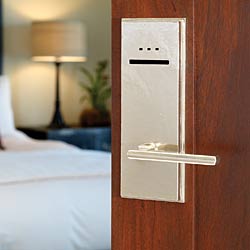Door Hardware Comes of Age
Considerations in Selecting a Hardware Manufacturer
Selection of a hardware manufacturer with the ability and the technologies to implement the design is vital to a successful application. The manufacturer should offer a range of options in cohesive styles, materials, and design appearances, thus allowing the design professional to create the desired aesthetic look. The choices for lever, knob, escutcheon, patina, in various sizes to work with the size and scale of the project, contribute to an integrated end result.
Ideally, hardware manufacturers should possess custom capabilities, allowing each piece to be as individual as the spaces they complement and the people who design and use them. Design professionals should consider manufacturers with in-house engineering and design teams, capable of collaborating with architects to translate design ideas into aesthetic and functional spaces. Additionally, manufacturers offering other complementary accessories, such as hinges, doorstops, surface and cane bolts, doorknockers, and doorbell buttons, will simplify implementation of the design concept throughout the project.
|
Commercial & Hospitality Applications
High traffic, constant use, and security considerations are the main characteristics of commercial and hospitality hardware applications. Selecting the correct hardware in these areas is important in terms of safety and longevity of the hardware and doors. In areas such as train stations, ski lodges, country clubs, and office buildings, design professionals should choose hardware that is consistent with the durability required by the occupancy loads. The simpler the hardware is in operation, the more durable it will be. If a locking function is needed, doors may be secured using deadbolts, flush bolts, and surface bolts. The ability of the door and the hardware to accept security devices, such as card readers, is critical for these applications. Finishes are also important features. Metals that are powder coated or lacquered tend to peel, crack or scratch. Selecting a solid base metal, like bronze, will withstand use and naturally age with time.
In response to increased hurricane activity, coastal codes are becoming more stringent. It is important for design professionals to select hardware and door manufacturers who can meet all code demands without compromising design continuity.
Considerations for Specifying Hardware
Many factors come into play when selecting and specifying hardware. The following checklist will assist design professionals in determining the information needed to write the specification, and to enable manufacturers to provide all of the necessary components. This is a list of
features that will need to be pre-determined in order to write a thorough specification:
- Lock function and mechanisms (including mortise lock, dead bolt, and spring latch)
- Door thicknesses
- Backsets
- Handing
- Style (including interior/exterior escutcheon, interior/exterior handle)
- Finish
- Clear keying of doors on plans, elevations, and schedules that will allow the manufacturer and other related vendors to make accurate quantity take-offs by location and type of hardware set.
Differences between European and U.S. Practice
European and Asian hardware requirements vary from the U.S. However, most of the differences lie in the lock mechanism. Selecting a hardware manufacturer with advanced custom capabilities allows design professionals to specify the country-approved mechanism by
custom fitting trim. Depending on the country, mechanisms will be approved for use, and provide a comfort level for users. Building owners should be confident that their local locksmith could fix any problems.
As with hardware codes, European lock mechanisms cannot be grouped together. Country practices and regulations vary from one to the next, and sometimes this varies within borders. Each country and region uses a specific type of lock mechanism, commonly a profile cylinder or one using a bit key. Regardless, it is this mechanism that they are comfortable with and continue to use.
For example, many U.S. window and door manufacturers have adopted the "European Multi-Point" three-point locking system for their U.S. products. Matt Ostmann, Technical Director at Rocky Mountain Hardware, observes that, "For many users this has been, and continues to be, a difficult mechanism to adopt because it simply functions differently than a typical U.S. locking system. Lifting up on a lever handle to release the three locking points is not well understood or natural for Americans to conform to, even though it is a technically effective approach to opening and closure."
One system is not necessarily better than another, but depends upon what users are accustomed to. Therefore, any hardware manufacturer must go through a significant amount of research, trial, and error testing, before globalizing a product.











